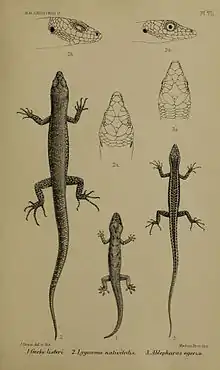Cryptoblepharus egeriae
Cryptoblepharus egeriae, the Christmas Island blue-tailed shining-skink, blue-tailed skink, or Christmas Island blue-tailed skink, is a species of skink, a lizard native to Australia's Christmas Island, and is not closely related to the Plestiodon skinks of North America, whose juveniles are known for their blue tails. It is relatively small with a black body with yellow stripes going to a bright blue tail. It is currently extinct in the wild.
| Christmas Island blue-tailed shining-skink | |
|---|---|
 | |
| 1900 monograph of three Christmas Island reptiles, with the Christmas Island blue-tailed shinning-skink at right. | |
| Scientific classification | |
| Kingdom: | Animalia |
| Phylum: | Chordata |
| Class: | Reptilia |
| Order: | Squamata |
| Family: | Scincidae |
| Genus: | Cryptoblepharus |
| Species: | C. egeriae |
| Binomial name | |
| Cryptoblepharus egeriae (Boulenger, 1888) | |
| Synonyms[2] | |
The Christmas Island Blue-Tailed Skink was discovered in 1886.[3] In 2002 scientists with the Christmas Island National Parks discovered that species of ants called Anoplolepis gracilipes (yellow crazy ant) were becoming a threat to the Christmas Island Blue-Tailed Skink.[4] Since their introduction in 1980 the yellow crazy ants had started to disrupt the biodiversity on Christmas Island.[4] This discovery put the Christmas Island Blue-Tailed Skink on the endangered animals list.[5] By 2009 Taronga Zoo decided to start an active breeding program in hopes of being able to release some of the skinks back into the wild.[6] However, by 2010 the Christmas Island Blue-Tailed Skink was extinct in the wild.
Etymology
The specific name, egeriae, is in honor of HMS Egeria.[7]
Evolutionary relationships
C. egeriae is most closely related to the metallicus group of Cryptoblepharus, native to Australia, with the estimated divergence of C. egeriae from the group taking place around 7 million years ago,[8]
See also
References
- Woinarski, J.C.Z.; Cogger, H.; Mitchell, N.M.; Emery, J. (2017). "Cryptoblepharus egeriae". IUCN Red List of Threatened Species. 2017: e.T102327291A102327566. doi:10.2305/IUCN.UK.2017-3.RLTS.T102327291A102327566.en. Retrieved 18 November 2021.
- "Cryptoblepharus egeriae ". The Reptile Database. www.reptile-database.org.
- Boulenger, G. A. (20 August 2009). "On the Reptiles of Christmas Island". Proceedings of the Zoological Society of London. 56 (1): 534–536. doi:10.1111/j.1469-7998.1888.tb06729.x. ISSN 0370-2774.
- "Yellow crazy ant biocontrol". parksaustralia.gov.au. Retrieved 24 March 2022.
- "Options beyond captivity for two critically endangered Christmas Island reptiles". www.nespthreatenedspecies.edu.au. Retrieved 24 March 2022.
- "Saving the Blue-Tailed Skink". Saving the Blue-Tailed Skink | Taronga Conservation Society Australia. Retrieved 24 March 2022.
- Beolens, Bo; Watkins, Michael; Grayson, Michael (2011). The Eponym Dictionary of Reptiles. Baltimore: Johns Hopkins University Press. xiii + 296 pp. ISBN 978-1-4214-0135-5. (Cryptoblepharus egeriae, p. 81).
- Oliver, Paul M.; Blom, Mozes P. K.; Cogger, Harold G.; Fisher, Robert N.; Richmond, Jonathan Q.; Woinarski, John C. Z. (30 June 2018). "Insular biogeographic origins and high phylogenetic distinctiveness for a recently depleted lizard fauna from Christmas Island, Australia". Biology Letters. 14 (6): 20170696. doi:10.1098/rsbl.2017.0696. PMC 6030605. PMID 29899126.
Further reading
- Boulenger GA (1888). "On the Reptiles of Christmas Island". Proc. Zool Soc. London 1888: 534–536. ("Ablepharus egeriæ ", new species, pp. 535–536).
